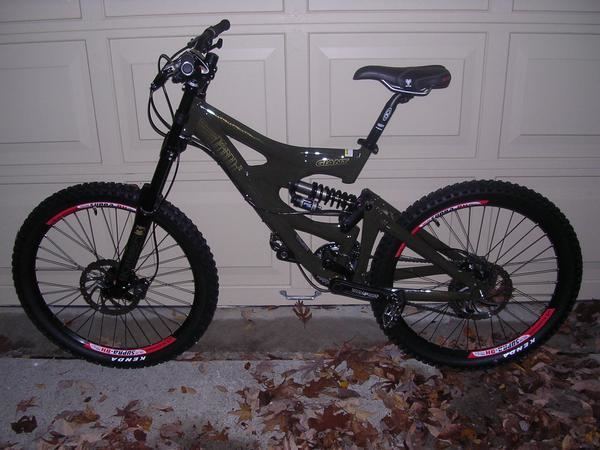 | ||
A downhill bike (also known as a downhill mountain bike) is a full suspension bicycle designed for downhill cycling on particularly steep, rocky trails. Unlike a typical mountain bike, durability and stability are the most important design features, compared to lighter, more versatile cross-country bikes. Downhill bikes are primarily intended for high speed descent, and downhill riders will usually push, or shuttle via chairlifts or motorized vehicles, to the trailhead. Downhill bikes are also very similar to freeride bikes due to large strong frames and more travel.
Contents
Geometry
These bikes will also have very slack head tube angles (66 degrees or less), long wheelbases (over 45 inches or 1,143 mm), and will accommodate the use of up to 3-inch (76.2 mm) width knobbed tires. Downhill frames are also overbuilt to handle the stress of riding over rocky terrain, drops, and jumps. Bike weights have been typically over 34 lb (15.4 kg), but modern downhill bikes have broken the 30 lb (13.6 kg) weight barrier (with some custom builds on carbon frames weighing between 27-29 pounds) Some newer (2014/5) downhill bikes can be built to weigh under 30 lb (13.6 kg), such as the Trek Session 9.9 or Kona Supreme Operator.
Adjustable head tube angles are also available to adapt the bike to the owner's preferred style of riding.
Suspension
Will typically have 7–10 inches (178–254 mm) of rear suspension travel, and be designed around a 7–8-inch (178–203 mm) suspension fork. The suspension sag is also much higher than cross-country bikes (25%-50% of total travel vs. 10%-20%) for a more supple ride at higher speeds.
Forks
Other innovations include the use of OnePointFive head tube standard, which uses a 1.5 in (38 mm) wide steerer tube, instead of the more conventional 1.125 in (29 mm) diameter, for added stiffness and strength. Most downhill bikes use dual crown forks which allow longer travel at the front(usually 203 mm or 8 in and increased stiffness that a single crown fork cannot offer. Drawbacks though, are increased weight and reduced turning circle.
Brakes
Downhill bikes usually have hydraulic disc brakes.
Drivetrain
Downhill bikes usually have a chain guide to prevent accidental chain deraillment. Some manufacturers are experimenting with internal gearboxes for improved reliability.
Tires
Downhill bikes have very thick and big tires in order not to lose traction in bad terrain.
Materials
Downhill bikes are typically made of aluminum alloys or carbon fiber.
